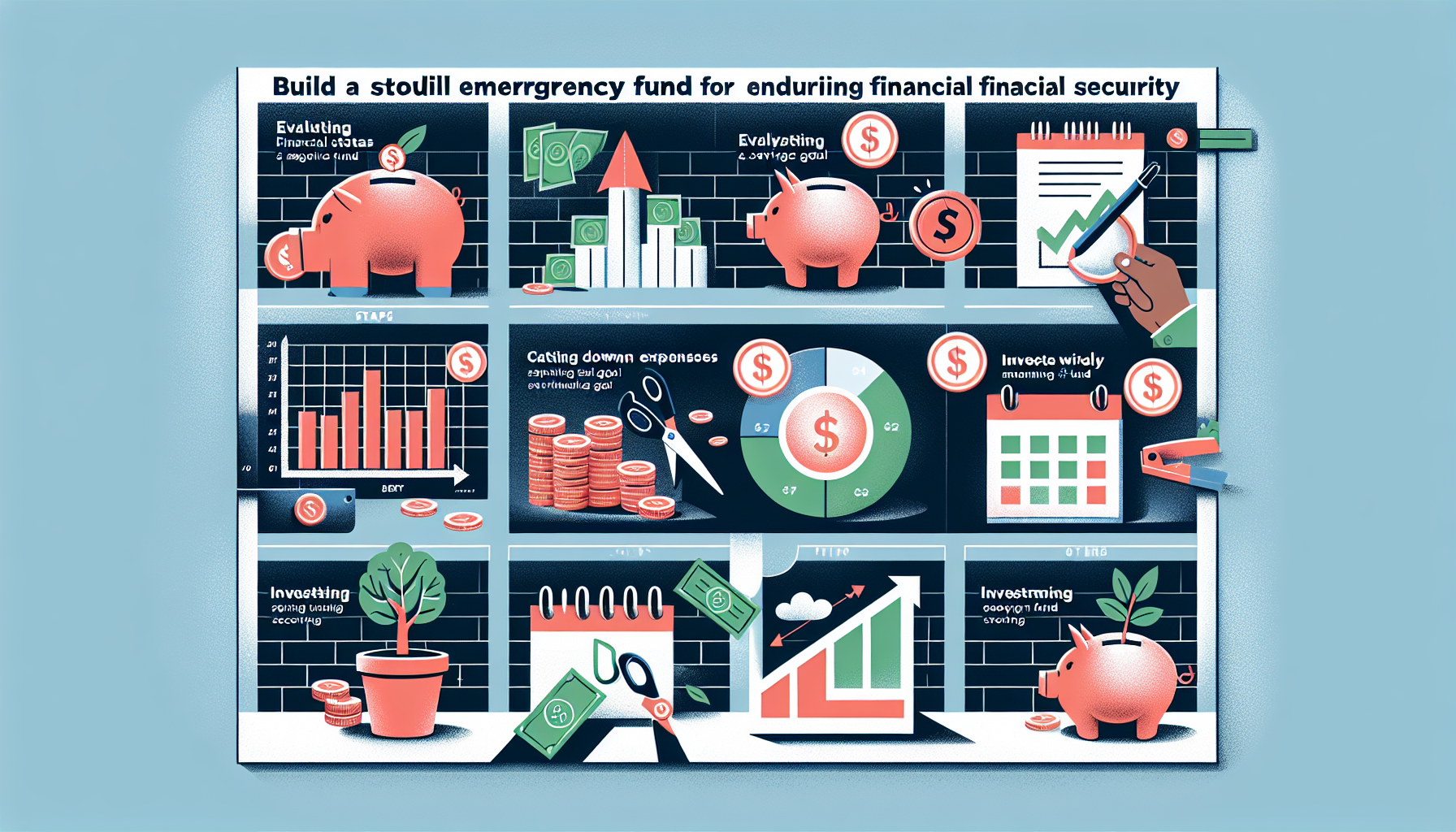Uncategorized
How to Build an Unshakeable Emergency Fund for Lasting Financial Peace

Understanding the Importance of an Emergency Fund
Creating a solid emergency fund is a cornerstone of financial stability. Unexpected expenses like medical bills, car repairs, or sudden unemployment can hit anyone at any time. An emergency fund acts as a financial buffer, allowing you to weather these storms without derailing your financial health.
How Much Should You Save?
There is no one-size-fits-all answer, but a general rule of thumb is to have three to six months’ worth of living expenses. Consider factors such as job stability, family size, and monthly expenses when determining what amount is right for you.
Step 1: Calculate Your Monthly Expenses
✅ Assess rent/mortgage, utilities, groceries, and other essential costs.
✅ Calculate discretionary spending to get a full picture of your outlay.
Step 2: Set a Realistic Savings Goal
✅ Start small if you’re new to savings—aim for $500 initially.
✅ Gradually increase until your emergency fund goal is met.
Strategies for Building Your Emergency Fund
Automate Your Savings
Set up an automatic transfer from your checking account to a savings account dedicated to emergencies. This ensures regular contributions without the temptation to spend that extra cash.
Reduce Unnecessary Expenses
Analyze your budget for areas to cut back, such as dining out or subscriptions you don’t use. Redirect these savings into your emergency fund.
Boost Your Income
Consider side gigs or freelance work to accelerate your fund-building efforts. Even a few extra hundred dollars a month can make a significant difference.
Where to Keep Your Emergency Fund
Your emergency fund should be accessible but not too easily spent. High-yield savings accounts or money market accounts are ideal choices, offering better returns than standard savings accounts while keeping your money relatively liquid.
FAQs About Emergency Funds
How soon should I start building my emergency fund?
💸 The best time to start is now, even if you can only save a small amount initially. Time is on your side, and consistency is key.
What if I already have debt?
🗓 Prioritize building a modest initial emergency fund ($500-$1000), then focus on accelerating debt repayment. Once debt is under control, continue growing your fund.
Can I invest my emergency fund?
📊 It’s advisable to keep your emergency fund liquid and risk-free. Investing it in volatile assets could compromise its availability when needed most.
In conclusion, while building an emergency fund can feel daunting, following these steps and maintaining a consistent approach will lead you to financial security. Start today, plan wisely, and protect your future.
Uncategorized
Mastering Financial Literacy: Empower Your Future Today!

Mastering Financial Literacy: Empower Your Future Today!
Financial literacy is more than just understanding numbers — it’s about making informed decisions that manifest in a secure and prosperous future. Whether you’re grappling with debt, learning how to budget effectively, or seeking ways to invest wisely, this guide is designed to empower you every step of the way.
Understanding Financial Literacy
Financial literacy encompasses the skills and knowledge that allow you to make informed and effective money-management decisions. It’s critical in developing responsible money habits and achieving financial independence.
Why Financial Literacy Matters
- Improves your ability to manage financial resources effectively for lifetime security.
- Enables informed financial decision-making.
- Enhances your ability to budget, save, and invest wisely.
Building a Budget That Works
Creating a budget is the cornerstone of financial stability. Follow these actionable steps to craft a budget that aligns with your goals and lifestyle:
Steps to Effective Budgeting
- Assess Your Income and Expenses: List all your income sources and monthly expenses. Be thorough!
- Set Clear Goals: Establish short-term and long-term financial goals. This will guide your budget priorities.
- Create a Plan: Allocate funds to each expense category, ensuring essential costs are covered first.
- Monitor and Adjust: Regularly review your budget and make adjustments as needed to meet your goals.
Strategies to Effectively Manage Debt
Debt can be a significant hurdle to financial freedom. Implement these strategies to manage and eliminate debt effectively:
Debt Reduction Techniques
- Debt Snowball Method: Pay off smallest debts first to build momentum.
- Debt Avalanche Method: Tackle high-interest debts first to minimize cost over time.
- Consider Consolidation: Streamline payments with a debt consolidation loan if it reduces interest rates and costs.
Investing for Long-term Wealth
Investing is a powerful tool for building wealth over time. Start early and consider these smart strategies:
Investment Tips
- Diversify Your Portfolio: Spread investments across different asset types to mitigate risk.
- Contribute Regularly: Set up automatic contributions to investment accounts.
- Educate Yourself: Continuously learn about markets and instruments to refine your strategy.
FAQs on Financial Literacy
- What is financial literacy and why is it important? Financial literacy involves understanding and using various financial skills effectively. It’s crucial for making sound financial decisions and achieving independence.
- How can I start learning about personal finance? Begin by reading articles, books, and taking online courses focused on budgeting, saving, and investing.
- What are some basic investing tips for beginners? Start with setting clear goals, learning about different investment vehicles, and considering working with a financial advisor if needed.
Mastering financial literacy is a journey. By applying these principles, you’ll not only gain control over your finances but also pave the path to a more secure and prosperous future. 💸
Uncategorized
SEO-optimized title that sparks curiosity and delivers value

Write a well-structured blog article of up to 5000 words, fully optimized for SEO. The content should be geared toward readers who want to improve their financial life — whether they’re paying off debt, learning how to budget, saving for the future, or exploring smart ways to invest and protect their income.
Focus on practical advice, responsible money habits, and easy-to-follow strategies that help people build lasting financial stability, regardless of their current income or experience.
⚙️ Apply SEO techniques:
Use
and
subheadings with the main keyword and natural variations
Include checkmark ✅ or bullet lists where helpful
End with a FAQ block answering real and common questions on the topic
Use emojis 💸📊🏡 where appropriate to keep the tone friendly and relatable
Make sure the article is accurate, up-to-date, and formatted in clean HTML. Maintain a clear, accessible, and empowering tone. Deliver content with authenticity, financial responsibility, and encouragement. Help the reader take control of their money, build confidence, and make informed decisions that support their future.
Uncategorized
Unlock Financial Success: Essential Personal Budgeting Strategies You Need to Know

Write a well-structured blog article of up to 5000 words, fully optimized for SEO. The content should be geared toward readers who want to improve their financial life — whether they’re paying off debt, learning how to budget, saving for the future, or exploring smart ways to invest and protect their income.
Focus on practical advice, responsible money habits, and easy-to-follow strategies that help people build lasting financial stability, regardless of their current income or experience.
⚙️ Apply SEO techniques:
Use
and
subheadings with the main keyword and natural variations
Include checkmark ✅ or bullet lists where helpful
End with a FAQ block answering real and common questions on the topic
Use emojis 💸📊🏡 where appropriate to keep the tone friendly and relatable
Make sure the article is accurate, up-to-date, and formatted in clean HTML. Maintain a clear, accessible, and empowering tone. Deliver content with authenticity, financial responsibility, and encouragement. Help the reader take control of their money, build confidence, and make informed decisions that support their future.
-

 Fashion8 anos ago
Fashion8 anos agoThese ’90s fashion trends are making a comeback in 2017
-

 Entertainment8 anos ago
Entertainment8 anos agoThe final 6 ‘Game of Thrones’ episodes might feel like a full season
-

 Fashion8 anos ago
Fashion8 anos agoAccording to Dior Couture, this taboo fashion accessory is back
-

 Entertainment8 anos ago
Entertainment8 anos agoThe old and New Edition cast comes together to perform
-

 Sports8 anos ago
Sports8 anos agoPhillies’ Aaron Altherr makes mind-boggling barehanded play
-

 Business8 anos ago
Business8 anos agoUber and Lyft are finally available in all of New York State
-

 Entertainment8 anos ago
Entertainment8 anos agoDisney’s live-action Aladdin finally finds its stars
-

 Sports8 anos ago
Sports8 anos agoSteph Curry finally got the contract he deserves from the Warriors


